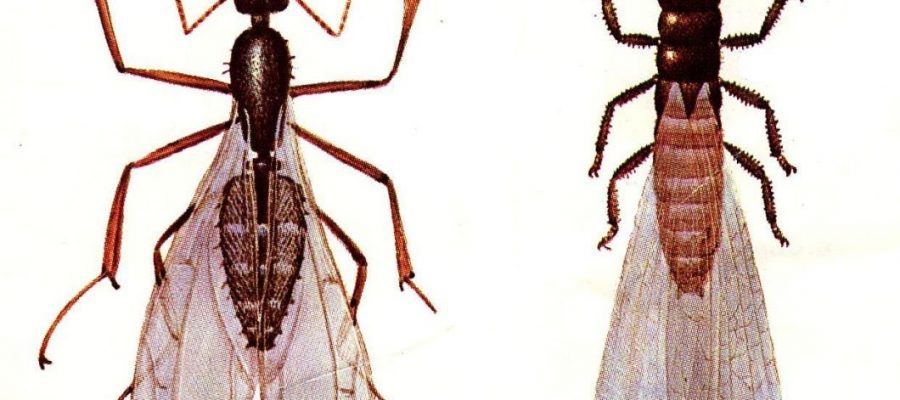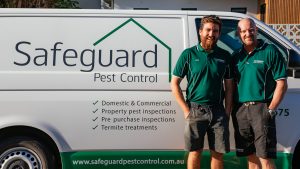Flying Ants or Termites?
- August 12, 2019
- in Pest Control
- by Rod Greer
- 98
- 0

The termites are the most invasive and destructive pests in the world, causing billions of dollars of damage all over the world. They multiply really fast and a termite queen can lay millions of eggs each year. In this article, we will discuss more about these nasty insects, about how they can get to your home, how they can be removed and find out how to know the answer to the question: flying ants or termites?
The termites need cellulose in order to survive and they get it from various sources such as wood, paper, wires and various other materials around your home and yard. They are among the few species that can actually digest cellulose, which makes them an important part of many ecosystems, but not so important to your home.
Subterranean termites need to get moisture from the soil, so they enter the home through any contact point between wood and the ground (doorframes, porch steps, deck posts and more). They are able to enter through the tiniest cracks, and that’s why termite treatments need to be carefully applied by professionals in order to cover the entire area and not leave any weak spots. They can crawl through cracks in the foundation, cracks in the brick mortar, and even holes in concrete blocks.
Termites are attracted by:
– Moisture
– Mulch
– Gardens
– Landscaping timber
– Furniture
– Cardboard boxes
– Documents
– Firewood
– Wood piles
– Dead trees
– Stumps
– Bad drainage
– Tree limbs close to the home
Most Australian homeowners have at least one of these “termite magnets” in their home or yard, and that’s why these insects are so common. They have plenty of sources of food and the right temperature and humidity to thrive.
Here are some of the indications that your home might be infested with termites:
– you find termite droppings
– the floors, walls or ceiling are damaged
– the foundation is damaged
– the garden is damaged
– roof tiles are damaged
– clicking noises
– headbanging
– flying termites
– termite wings
– white ants
– the timber sounds hollow
– there are small holes in the wood
– the doors and windows are hard to open or close
– mud leads
– shelter tubes
– the power fails
– you notice tunnels in wood
If you notice any of these signs, it’s time to call a professional. And the sooner you do it, the better it will be in the long term. Don’t waste your time with DIY solutions found on the internet.
There are thousands of species of termites all over the world, but they can all be included in a few categories and groups. In every colony we have:
– the alates
– the king and the queen
– the termite soldiers
– the termite workers
There are also three main types of termites, and they are:
– subterranean termites
– drywood termites
– dampwood termites
Termites are small insects with a straight waist, straight antennae, and usually a white or translucid colour. They are quite similar to ants, and the two species are usually mistaken by people. The ones who get confused the most are the swarming termites and the flying ants. Here are the main differences between the two, so you know how to identify them:
– The waist of the termites is straight, while that of ants is pinched
– The antennas of termites are also straight, while those of ants are bent
– The four wings of termites all have the same length, while those of ants have different lengths. Also, flying ants do not shed their wings, while termites do. So if you find any wings somewhere in your home, then it’s a bad sign: it means that termites just established a nest somewhere on your property
By applying the knowledge mentioned above, you can now tell the difference between flying ants and flying termites. If you only find flying ants, then it’s ok. But if those that you find in your home or backyard are flying termites, then you have a big problem and you need to take action right away.
Multiple types of termite treatments are available, depending on the type of insects you have, the surface that is affected, the particularities of your home and so on. After a careful inspection of your property, the pest control technician will present you with the best possible solution for your home.
Among the possible types of treatment, we have:
– Liquid Insecticides – it’s applied by a specialist in the infested areas
– Foam Treatments – it’s used when the termites are hidden deep inside a wall or a large piece of wood and where liquids can’t be applied. The foam expands and fills in all the space inside the galleries. This pushes the foam through the entire gallery, trapping the insects inside
– Dust Treatments – it works in a similar way as the foam, trapping the termites inside and then gradually killing the entire colony
– Termite Barriers – a barrier offers long term protection and is installed around the entire perimeter of your home
– Termite Baits – while they take more time to work, baits are also an effective method of getting rid of termites.
DIY solutions found online and in retail stores offer short term protection for just a few days or weeks. So they are definitely not a good option. However, professional treatments offered by specialized companies can offer protection for up to 8 years. They are applied with special tools and devices, one of them being the barrier rig. This device injects the product deep into the soil and at high pressure, to ensure that the desired area is saturated and the substance reaches the nest.
The price depends on the type of treatment that is applied and on the surface of your property. The larger the surface, the more pesticide will be needed, so the higher the price will be.
A “quick fix” treatment with foam or dust can cost between 300 and 900 dollars. These substances do not kill the termites on the spot, but rather allow them some time to get to the nest and infest the entire colony.
However, if the colony is large and spread over a large surface, then a full treatment is required. In this case, there are two possible options: termite barriers and termite baiting.
A barrier offers protection from any angle against subterranean termites that can fit through even the tiniest holes. The price for a termite barrier varies between $1,500 and $5,000 and it offers protection for up to 8 years. Our termite barriers follow all the health and environment safety guidelines and are safe and effective.
Baiting is done with items that termites love the most (such as wooden stakes, cardboard, paper or objects containing their favourite food – cellulose). These items are initially non-toxic until the presence of the pests is confirmed. They can be checked every month, and when termites are detected, a slow-acting termiticide is used. Its aim is to infect and destroy the entire colony. The annual cost of termite baiting might be somewhere between $2,000 and $4,000, depending on various factors.
A traditional chemical barrier may not be enough, as the perfect protection is very hard to achieve. Their application is also difficult, and it may be necessary to drill through concrete. And even so, the termites can find the tiniest hole and still enter the area. So a backup form may be needed, in the form of termite baiting.
So the best way to go about it is to use both a termite barrier and baits. This will guarantee that termites will be detected and killed before they get the chance to destroy your home.
The best way to get rid of termites is with the help of a professional company. Safeguard Pest Control is a family-owned and operated business that has been around since 1989. We offer pest control solutions to both residential and commercial areas, as well as to schools and hospitals. We are using modern devices and safe substances that will not affect your health or the environment.

Our team of experts will arrive as soon as possible and will begin by inspecting the particularities of your home. After finding the problem, we will come up with a custom action plan and we will get to work. Our treatments suit all types of homes and all budgets. Contact us today and let us help you get rid of termites! Call 07 5477 6675 or send us an e-mail at info@safeguardpestcontrol.com.au
Array